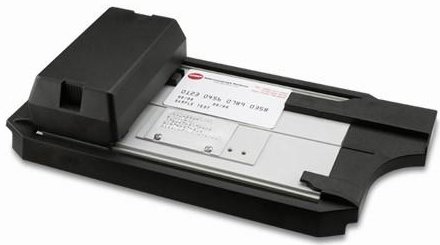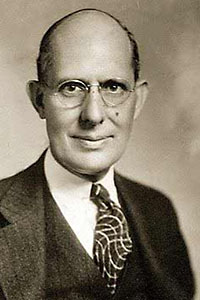
The typical car dealer processes a lot of payments every day. Between the F&I office, the cashier, the service desk, the parts counter, and perhaps a leasing or rental desk, a lot of money changes hands.
Before electronic ticket capture for credit cards (swiping the magnetic stripe in a card reader), here’s how it worked:
The cashier put the credit card into a big, heavy device called an imprinter, or more commonly, for obvious reasons, a “knuckle-buster.” Then she inserted a five-part form and slid the imprinter over the card, which would imprint the raised lettering from the front of the card on the forms via carbon paper.
The cashier would have to extract the forms and the carbons, give one copy to the consumer, keep one for the business, and send two copies to their credit card processor (and then bandage her fingers and wash her hands).
But, before she did that, you, the owner or manager, had to go through a weekly printed update provided by Visa and MasterCard that was about the size of a small town’s telephone book, and look up the card number to be sure that it had not been compromised.
This was not a user-friendly product.
Knuckle-busters to Phone Lines
 I am a car collector, so I want to round out this history lesson by telling you about one of the most famous personalities in the entire history of the automobile: Charles F. Kettering.
I am a car collector, so I want to round out this history lesson by telling you about one of the most famous personalities in the entire history of the automobile: Charles F. Kettering.
Kettering had over 100 patents. He developed the first automotive electronic ignition system, including the self-starter. His technology (the self-starter, a system for interchangeability of parts, and electric lighting) made Cadillac “The Standard of the World” at the time.
Every auto historian knows about Kettering, but there’s a lot more to his story.
Kettering dropped out of high school due to poor eyesight. He dug post holes for an Ohio telephone company while getting his engineering degree. His first job was working for National Cash Register, and he developed the first electronic cash register, the first POS system!
If you think it’s difficult to sell POS systems now, imagine what the person selling the first cash register had to deal with.
For one thing, in those days, all transactions were cash, and the person at the register customarily took a little out of every transaction. This was called “a taste of the till.” Do you think that the merchant’s clerk would be receptive to a new product that would keep a complete financial and inventory record of every transaction? Obviously not!
Phone Lines to Magnetic Stripes
Then a Big Change happened that made life easier for today’s cashier, who long ago gave up on “tasting the till.”
Starting in 1981, Visa and MasterCard offered discounts if you used their new “automated transaction technology” for payments over $50. It was expensive – early magstripe readers cost around $900, a lot of money in 1981 dollars. But then in 1984, Verifone introduced the Zon Junior, which sold for $125, and suddenly, every merchant could use ETC – electronic ticket capture.
That was a Big Change! (The other advantage was that the Zon Junior was bulletproof. Once, as a test, we drove over one with a car and it still worked perfectly!).
To get a real-time authorization, you had to send a query over a telephone line. Now imagine what it would take if you had say twenty retail stores and ten terminals per store! Just configuring the telephone lines took a tremendous amount of expertise.
Incidentally, people forget that back then, there was no Internet, and the only “cloud” was the cloud that appeared over your head when the cardholder did a chargeback or the acquirer raised their rates.
Magnetic Stripes to NFC – Or Else!
Kettering never stopped innovating, setting a great example for the rest of us.
His lab developed fuel for high-compression auto engines, quick drying enamel paint, synthetic aviation fuel, and the refrigerant Freon. He helped develop the General Motors Institute, now renamed Kettering University in his honor.
You have doubtless heard of the Sloan-Kettering Institute for Cancer Research, which he founded in 1945. The combination of Kettering running R&D and Alfred Sloan’s implementation of modern business management techniques made G.M. the largest industrial corporation in the world for many years. To learn more, check out Sloan’s autobiography, My Years with General Motors. This is one of the classics of business literature. You won’t be disappointed.
Since 1981, nothing much changed in the card processing environment – until the advent of Near Field Communications (NFC). Despite Google’s early attempts, NFC remained flash in the pan until Apple figured that it wanted to be involved in payments, releasing the ApplePay application on the iPhone 6.
But there’s still no meaningful consumer transaction volume using mobile payments, because out of the 11 million card terminals out there, only about 220,000 are NFC enabled right now. But we all know that this is going to change, Big Time, and soon.
Part of the change is being spurred along the same way that Visa and MasterCard did it back in 1981 – by enforcing it!
Soon, if your terminal will not take EMV (chip and signature cards) the liability for a fraudulent transaction will shift from the acquirer to the merchant. The card networks figure this should be scary enough to motivate the merchants to replace all their terminals to accept both EMV and NFC. The cost of replacing all the card terminals in the country will be in the tens of billions of dollars – not a trivial undertaking.
Too Expensive for Auto Sales
It’s no secret that car dealers do not like to take credit card payments for high dollar transactions. The dealer is typically going to make a gross profit of about $1300 on a new car sale, and they don’t want to pay 3% to the card processor.
If someone used a card for the whole purchase price (typically $31k on a new car) that might amount to $930, most of their gross profit from the deal!
Now, an auto dealer may say, “I’m only paying 1.75%,” which is what we hear all the time. But when we take the card statement and divide the total fees by the total dollars processed, it is always over 2.5% and typically closer to 3%, much to the amazement of the dealer!
A Better Solution – No Interest, No Credit Check Required
We have a better way. Ask the consumer if they want to pay with an electronic check. No, I don’t mean an ACH debit or debit card.
As a merchant, you want the protection of the Uniform Commercial Code and 200 years of banking law for your payments, not the rules and regulations of the National Automated Clearing House, or Regulation E, a consumer protection statute!
And no, you cannot write down the consumer’s debit card number and re-enter it a few weeks later for recurring transactions – this is a major violation of banking and Card Network rules that can cause you to lose your card processor faster than a speeding bullet.
With the CrossCheck electronic checking product, you just swipe up to four checks in the imager we provide and give the original checks back to the consumer. That’s all there is! We do your banking for you and deposit the full face amount into any bank account anywhere in the country.
You will so no gaps in funding for returned checks covered under a service agreement.
If you have multiple stores, we provide full reporting of sales by store, by department, and there is no worry about the checks not being deposited on the correct date, because we take responsibility for that!
Best of all, you will pay only about a third of what you would pay for a credit card transaction! Learn more about Multiple Check here and below.
Kettering Got Here First, Too!
Incredibly, Kettering also designed a credit approval system that combined the telephone lines at the counters to solenoid-operated stamping machines located in the credit office. This allowed the credit department to check customer records to extend credit, and thus make a sale possible when the customer didn’t have enough cash with them at the point of sale. This was a revolutionary development, back before the days of the credit bureaus and the FICO score and Chexsytems!
Now the merchant could sell more products when the consumer didn’t have the money at the point of sale.
Of course, we have the same system today at CrossCheck: you swipe the checks through the imager and we come back in real-time with an approval number. The consumer tells you when to deposit the checks, and you get to make a sale that you wouldn’t otherwise make because the consumer does not have all the funds at that very moment when they are sitting down with the F&I manager and signing the paperwork.
Best of all, from the consumer standpoint, they do not have to apply for credit or pay interest.
I think Kettering would be impressed with this system. But Kettering would not be surprised by NFC. He would probably say, “What took you so long?”



